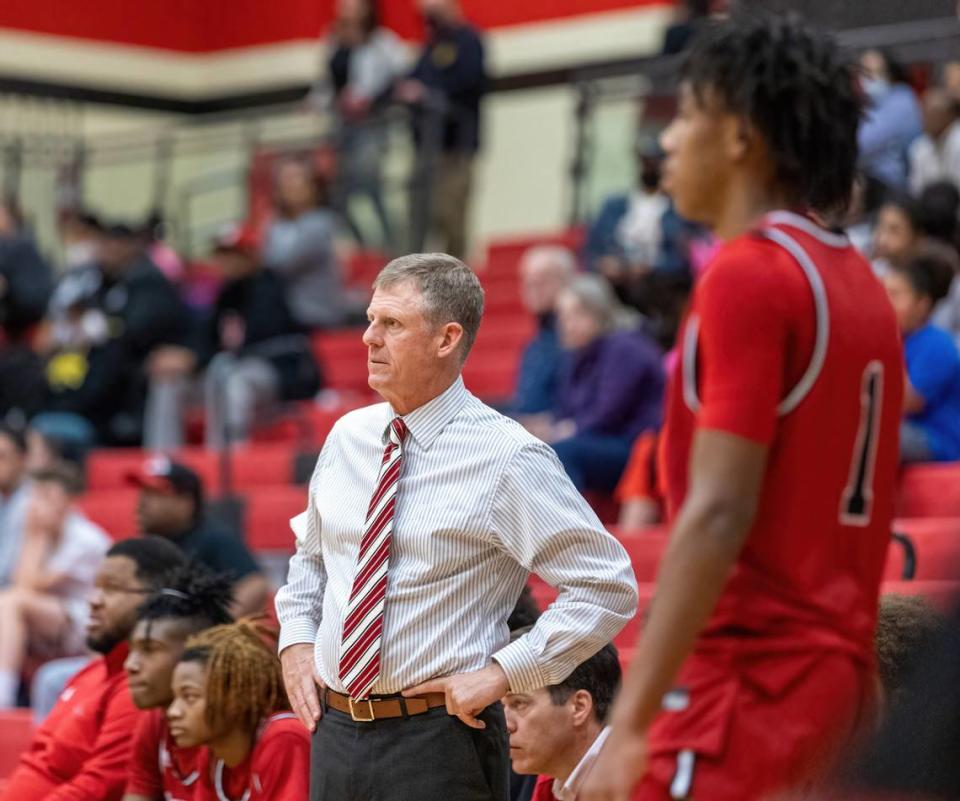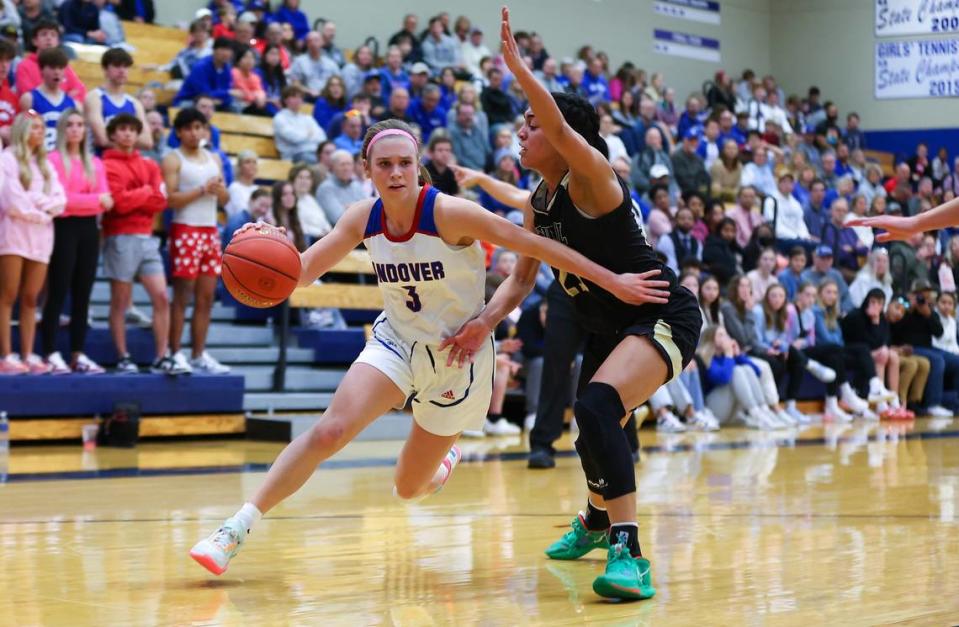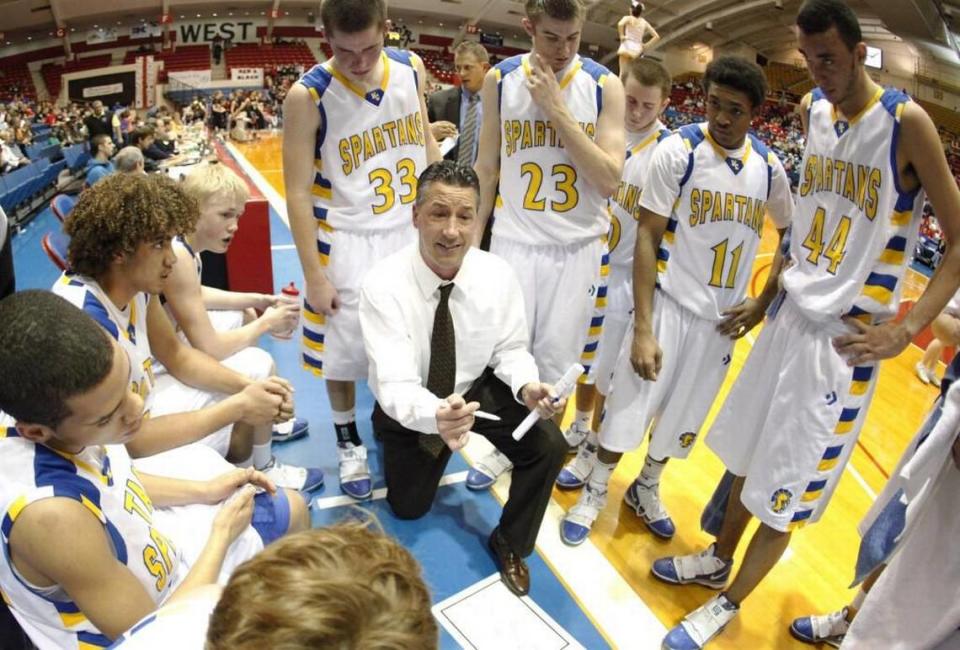The pros and cons of KSHSAA’s trial run for shot clock in Kansas high school basketball
- Oops!Something went wrong.Please try again later.
The 35-second shot clock is coming to Kansas high school basketball games on a trial basis for the 2024-25 season following approval from the Kansas State High School Activities Association Executive Board on Wednesday.
It will be up to each school to determine if it wants to use a shot clock for all home boys and girls varsity games. The trial only applies to regular-season games, meaning all postseason games will be played without a shot clock.
Wednesday’s ruling was met with enthusiasm from the majority of Kansas high school basketball coaches, while administrators seem to be taking a more cautious approach.
“The shot clock is a great thing for Kansas basketball and something that’s been overdue,” Maize South girls basketball coach Ben Hamilton said. “It’s going to make the most exciting sport even more exciting at the high school level.”

Why Kansas high school basketball coaches like the shot clock
According to support material provided by the KSHSAA, game officials have concerns that the introduction of the shot clock could lead to “potential deterioration of basketball skills.”
The argument is that the shot clock would lead to a more frenetic pace, which would in turn lead to more sloppy play.
High school basketball coaches, at least at the Class 6A and Class 5A level, where the shot clock is expected to be adopted by the vast majority of schools, passionately argue the exact opposite of the officials’ stance.
“This is the only way to play if we’re truly attempting to help varsity basketball players prepare for the game at the next level,” Wichita Heights boys basketball coach Joe Auer said. “Now your individual ball skills, your ability to create separation off the dribble, your ability as an individual to showcase your talents is definitely on display in a shot-clock game, where in a non-shot-clock game, there’s no incentive to do anything other than take the absolute best shot.
“And that’s great on one hand. Team basketball, everybody touches it, a lot of ball reversals, being very selective. But at the next level, you have to demonstrate the ability to create separation to score, to go off the dribble and get your shot off. I’m excited how this is going to reward guys who have good individual ball skills.”
Helping prepare players with aspirations of playing college basketball is important to coaches in larger classifications.
“We have a lot of kids in our program who want to play at the next level and I think this is going to be huge for Kansas kids,” Maize South girls basketball coach Ben Hamilton said. “It’s more action, more basketball. It’s great exposure for our kids and now they’re going to be more prepared to play at the college level.”
“There’s going to be more possessions in a game and now from a skill-development standpoint, you’re going to be facing end-of-clock situations now,” Derby boys basketball coach Brett Flory said. “It’s going to be good from a coaching and a skill perspective to have some things in place to be able to operate late clock. It’s certainly going to prepare players better for those who go on to college.”
But in the smaller classifications, stalling tactics are more prevalent and some coaches are concerned the shot clock would be taking away some strategy. In the 2022 Class 2A boys state tournament, Lyndon held the ball for minutes at a time in an upset bid that ultimately fell short in a 37-28 double-overtime loss.
Garden Plain girls basketball coach Kody Kasselman said he is “indifferent” to the shot clock, but could see why some coaches might not like it.
“I imagine most of our possessions are under 35 seconds, so I’m not sure how big of a change it will really be for us,” Kasselman said. “Where I think you would see a change is how some teams game plan differently if you’re out-matched. I know some teams like to slow it down. So it might take some of the strategy away, but I think people would adjust like anything else and it would just eventually become a part of the game.”

Why there is hesitation to embrace the shot clock
When Kansas Interscholastic Athletic Administrators Association polled school administrators this past October, the implementation of the shot clock was overwhelmingly shot down by a 279-116 margin.
A big reason why? The cost. According to a KSHSAA spokesperson, installing a shot clock will cost anywhere between $3,000 and $5,000 for schools.
Another reason why administrators are opposed to it? Because they know how difficult it is finding officials and the controversy that might arise over shot-clock issues.
“We’ll probably be a school who waits and sees how it goes for both of those reasons,” Hesston athletic director Clint Stoppel said. “We already have an official shortage, so trying to find someone who is trained and available to do the job is something to think about. The last thing we want is another reason for someone in the stands to be hollering at officials.”
During the trial run, the KSHSAA will ask administrators to complete a short survey following each game. The survey is not finalized, but it will be sure to inquire how many shot clock violations there were in the game and if any game stoppages occurred because of the shot clock.
The KSHSAA will collect data and observations throughout the season before making a more permanent decision about implementation following the 2024-25 season.
“There are some legitimate obstacles to overcome, but I don’t think the concerns are necessarily on-the-court concerns,” Derby boys basketball coach Brett Flory said. “They’re more logistical and administration-type concerns.”

Why some Kansas coaches might skip the shot clock trial
While the headline of the shot clock being introduced to Kansas high school basketball is exciting, some coaches were less than thrilled when they read the fine print.
“For some reason, unbeknownst to us, we’re not going to do it in the postseason,” Wichita Heights boys basketball coach Joe Auer said. “The idea we’re going to play a shot clock game all year and then play a much different style of basketball in the postseason, I can’t come up with a good reason for that.”
“It’s apples and oranges when you have a shot clock and when you don’t,” Derby boys basketball coach Brett Flory said.
While the shot clock is expected to be implemented for the majority of Class 6A and Class 5A schools, it is likely to be less popular in the lower classifications.
Collegiate boys basketball coach Mitch Fiegel, who competes at the 3A level, says he is fully on board with playing games with a shot clock but is considering not implementing the shot clock for the trial run because of the difference in postseason play.
“Why would I want to play by one set of rules for the entire season and then play by a different set of rules in the postseason?” Fiegel said. “The reason it’s okay to take a bad shot is because there’s a shot clock. So now I’m telling guys for 20 games to think it’s okay to take a bad shot because we’re at the end of the shot clock, then we start the postseason and expect them to behave differently? I’m not too excited about that.”
Coaches like Maize South girls basketball coach Ben Hamilton agree it’s not ideal, but believes the trial run is what is needed to eventually make the rule permanent.
“Not having it in the postseason is definitely something you’re not super excited about, but honestly, this is a baby step in the right direction for the game in Kansas,” Hamilton said. “I think it’s going to be a great thing and it’s going to continue to spread and I think you’ll see this at the 1A through 6A level in the next five years.”

